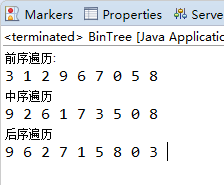二叉树概念:
java二叉树的每个根节点最多有两颗字数,不存在子树大于2的节点,也就是说,二叉树是节点的最大度数为2的树,通常子树分为左子树和右子树,次序不能颠倒。
创建二叉树:
public void createTree(Object[] objs) {
datas = new ArrayList<BinTree>();
for (Object object : objs) {
datas.add(new BinTree(object));
}
root = datas.get(0);// 将第一个作为根节点
for (int i = 0; i < objs.length / 2; i++) {
datas.get(i).leftNode = datas.get(i * 2 + 1);
if (i * 2 + 2 < datas.size()) {// 避免偶数的时候 下标越界
datas.get(i).rightNode = datas.get(i * 2 + 2);
}
}
}
二叉树的遍历有三种:
先序遍历:
-
访问根节点
-
按先序遍历访问左子树
- 按先序遍历访问右子树
// 先序遍历
public void preorder(BinTree root) {
if (root != null) {
visit(root.getData());
preorder(root.leftNode);
preorder(root.rightNode);
}
}
中序遍历:
- 按中序遍历左子树
- 访问根节点
- 按中序遍历访问右子树
// 中序遍历
public void inorder(BinTree root) {
if (root != null) {
inorder(root.leftNode);
visit(root.getData());
inorder(root.rightNode);
}
}
后序遍历:
- 按后序遍历访问左子树
- 按后序遍历访问右子树
- 访问根节点
// 后序遍历
public void afterorder(BinTree root) {
if (root != null) {
afterorder(root.leftNode);
afterorder(root.rightNode);
visit(root.getData());
}
}
运行代码:
public static void main(String[] args) {
Integer[] test = new Integer[] { 3, 1, 0, 2, 7, 5, 8, 9, 6 };
BinTree tree = new BinTree();
tree.createTree(test);
System.out.println("前序遍历:");
tree.preorder(tree.getRoot());
System.out.println();
System.out.println("中序遍历:");
tree.inorder(tree.getRoot());
System.out.println();
System.out.println("后序遍历:");
tree.afterorder(tree.getRoot());
}运行效果:

完整代码:
public class BinTree {
private BinTree leftNode;// 左子树
private BinTree rightNode;// 右子树
private BinTree root;// 根节点
private Object data; // 数据域
private List<BinTree> datas;// 存储所有的节点
public BinTree(BinTree leftNode, BinTree rightNode, Object data) {
super();
this.leftNode = leftNode;
this.rightNode = rightNode;
this.data = data;
}
public BinTree(Object data) {
this(null, null, data);
}
public BinTree() {
super();
}
public void createTree(Object[] objs) {
datas = new ArrayList<BinTree>();
for (Object object : objs) {
datas.add(new BinTree(object));
}
root = datas.get(0);// 将第一个作为根节点
for (int i = 0; i < objs.length / 2; i++) {
datas.get(i).leftNode = datas.get(i * 2 + 1);
if (i * 2 + 2 < datas.size()) {// 避免偶数的时候 下标越界
datas.get(i).rightNode = datas.get(i * 2 + 2);
}
}
}
// 先序遍历
public void preorder(BinTree root) {
if (root != null) {
visit(root.getData());
preorder(root.leftNode);
preorder(root.rightNode);
}
}
// 中序遍历
public void inorder(BinTree root) {
if (root != null) {
inorder(root.leftNode);
visit(root.getData());
inorder(root.rightNode);
}
}
// 后序遍历
public void afterorder(BinTree root) {
if (root != null) {
afterorder(root.leftNode);
afterorder(root.rightNode);
visit(root.getData());
}
}
private void visit(Object obj) {
System.out.print(obj + " ");
}
public Object getData() {
return data;
}
public BinTree getRoot() {
return root;
}
public static void main(String[] args) {
Integer[] test = new Integer[] { 3, 1, 0, 2, 7, 5, 8, 9, 6 };
BinTree tree = new BinTree();
tree.createTree(test);
System.out.println("前序遍历:");
tree.preorder(tree.getRoot());
System.out.println();
System.out.println("中序遍历:");
tree.inorder(tree.getRoot());
System.out.println();
System.out.println("后序遍历:");
tree.afterorder(tree.getRoot());
}
}





















 2120
2120











 被折叠的 条评论
为什么被折叠?
被折叠的 条评论
为什么被折叠?








